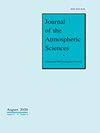A New Conceptual Picture of the Trade Wind Transition Layer
IF 2.8
3区 地球科学
Q2 METEOROLOGY & ATMOSPHERIC SCIENCES
引用次数: 4
Abstract
The transition layer in the trades has long been observed and simulated, but the physical processes producing its structure remain little investigated. Using extensive observations from the Elucidating the Role of Clouds–Circulation Coupling in Climate (EUREC4A) field campaign, we propose a new conceptual picture of the trade wind transition layer, occurring between the mixed-layer top (around 550 m) and subcloud-layer top (around 700 m). The theory of cloud-free convective boundary layers suggests a transition-layer structure with strong jumps at the mixed-layer top, yet such strong jumps are only observed rarely. Despite cloud-base cloud fraction measured as only 5.3% ± 3.2%, the canonical cloud-free convective boundary layer structure is infrequent and confined to large [O(200) km] cloud-free areas. We show that the majority of cloud bases form within the transition layer, instead of above it, and that the cloud-top height distribution is bimodal, with a first population of very shallow clouds (tops below 1.3 km) and a second population of deeper clouds (extending to 2–3 km depth). We then show that the life cycle of this first cloud population maintains the transition-layer structure. That is, very shallow clouds smooth vertical thermodynamic gradients in the transition layer by a condensation–evaporation mechanism, which is fully coupled to the mixed layer. Inferences from mixed-layer theory and mixing diagrams, moreover, suggest that the observed transition-layer structure does not affect the rate of entrainment mixing, but rather the properties of the air incorporated into the mixed layer, primarily to enhance its rate of moistening. The physical processes producing the structure of the trade wind transition layer, a thin atmospheric layer thought to be important for regulating convection, are not yet well understood. Using extensive observations from a recent field campaign, we find that the cloud-free convective boundary layer structure, with an abrupt discontinuity in thermodynamic variables, is infrequent, despite cloud-base cloud fraction being small. We show that very shallow clouds both forming and dissipating within the transition layer smooth vertical gradients compared to a jump, except in large [O(200) km] cloud-free areas. This condensation–evaporation mechanism, which is fully coupled to the mixed layer, does not appear to affect the rate of entrainment mixing, but rather the properties of air incorporated into the mixed layer.信风过渡层的新概念图
贸易中的过渡层长期以来一直被观察和模拟,但产生其结构的物理过程仍然很少被研究。利用“阐明云-环流耦合在气候中的作用”(EUREC4A)实地活动的广泛观测,我们提出了信风过渡层的新概念图,该过渡层发生在混合层顶部(约550米)和亚云层顶部(约700米)之间。无云对流边界层理论表明,过渡层结构在混合层顶部具有强烈的跳跃,但这种强烈的跳跃很少被观察到。尽管测得的云基云分数仅为5.3%±3.2%,但典型的无云对流边界层结构并不常见,仅限于大的[O(200)km]无云区域。我们发现,大多数云基形成在过渡层内,而不是在过渡层上方,云顶高度分布呈双峰型,第一组是非常浅的云(顶部低于1.3公里),第二组是更深的云(延伸到2-3公里深)。然后,我们证明了第一个云种群的生命周期保持着过渡层结构。也就是说,非常浅的云通过冷凝-蒸发机制平滑了过渡层中的垂直热力学梯度,该机制与混合层完全耦合。此外,从混合层理论和混合图的推断表明,观察到的过渡层结构并不影响夹带混合的速率,而是影响混入混合层中的空气的性质,主要是为了提高其润湿速率。信风过渡层是一层被认为对调节对流很重要的薄大气层,其产生结构的物理过程尚不清楚。利用最近一次野外活动的广泛观测,我们发现,尽管云基云的比例很小,但热力学变量突然不连续的无云对流边界层结构并不常见。我们表明,与跳跃相比,在过渡层内形成和消散的非常浅的云具有平滑的垂直梯度,但在大的[O(200)km]无云区域除外。这种与混合层完全耦合的冷凝-蒸发机制似乎不会影响夹带混合的速率,而是影响混合层中空气的性质。
本文章由计算机程序翻译,如有差异,请以英文原文为准。
求助全文
约1分钟内获得全文
求助全文
来源期刊

Journal of the Atmospheric Sciences
地学-气象与大气科学
CiteScore
0.20
自引率
22.60%
发文量
196
审稿时长
3-6 weeks
期刊介绍:
The Journal of the Atmospheric Sciences (JAS) publishes basic research related to the physics, dynamics, and chemistry of the atmosphere of Earth and other planets, with emphasis on the quantitative and deductive aspects of the subject.
The links provide detailed information for readers, authors, reviewers, and those who wish to submit a manuscript for consideration.
 求助内容:
求助内容: 应助结果提醒方式:
应助结果提醒方式:


